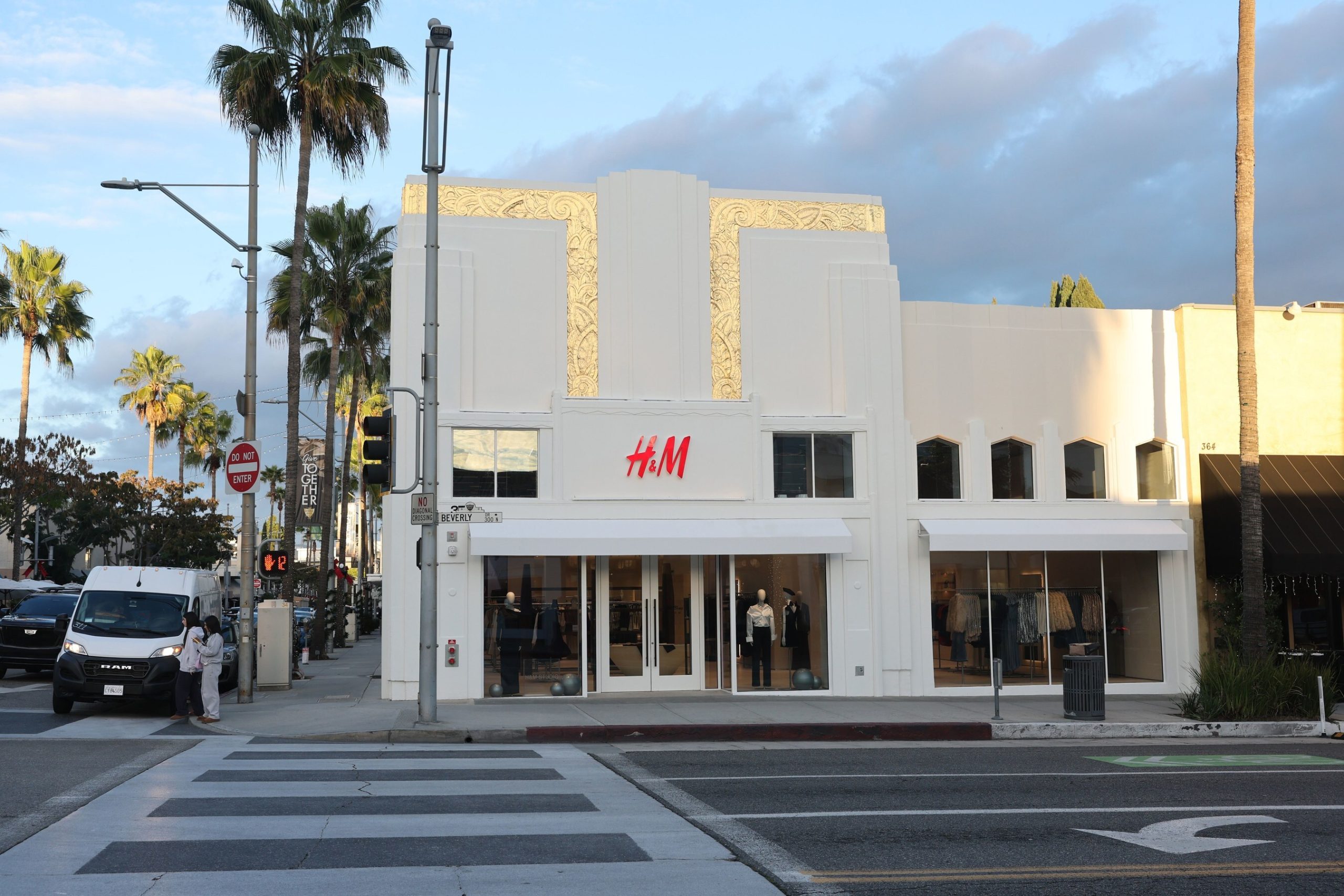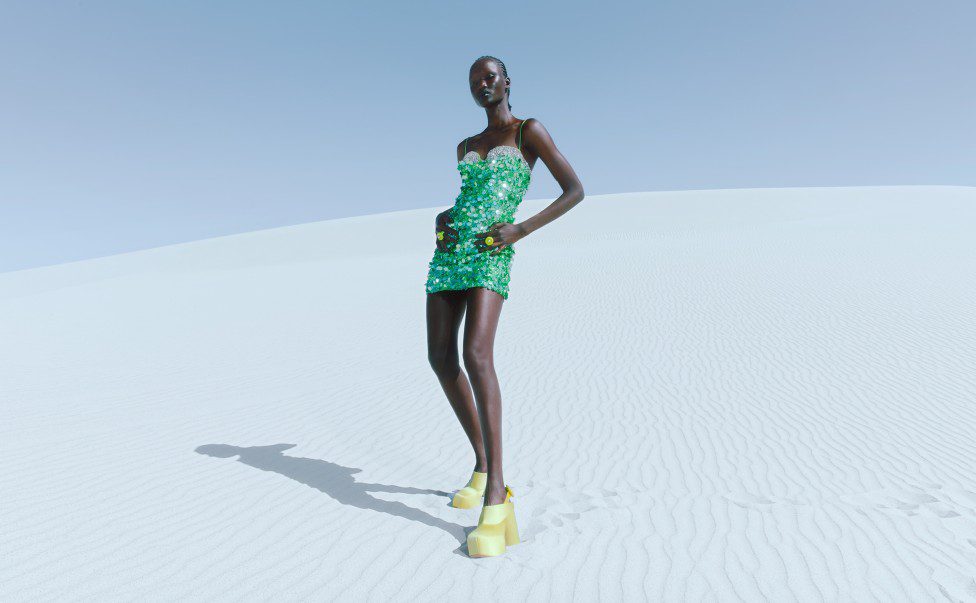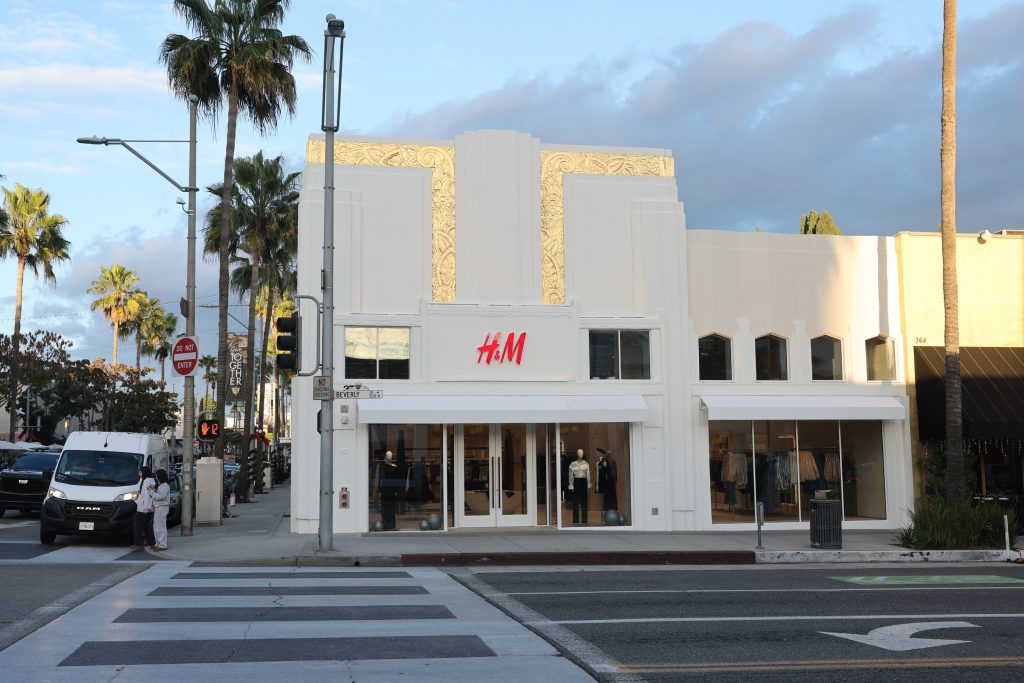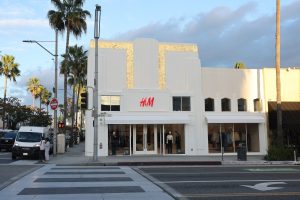H&M has opened its first store in Beverly Hills at 370 North Beverly Drive. This destination offers a handpicked curation of H&M elevated designs, special collections, fashion accessories and H&M Pre-Loved. The opening continues the company’s expansion into hyper-local, fashion-first formats, designed to deepen cultural relevance in global markets.

H&M Opens Its First Store In Beverly Hills
Spanning over 5,000 square feet, the Beverly Hills location is inspired by H&M’s Scandinavian heritage and the architectural history of California. Developed by H&M’s in-house architecture team, the store is set within a historic Art Deco landmark and features an open wood ceiling original to the structure, with interiors that include stucco-textured walls, tile flooring, architectural wood shelving, and travertine stone accents.
“With this new concept store in Beverly Hills, we’ve created more than a destination — we’ve created an experience. With a curated assortment and elevated interior features, and introducing our pre-loved concept, the store is a space where fashion is playful, personal and connected to culture” says Jörgen Andersson, Chief Creative Officer, H&M.
The opening also marks the debut of H&M Pre-Loved in Los Angeles, the brand’s curated secondhand line. H&M is partnering with Wasteland, a beloved LA-based vintage store known for its trend-forward curation and deep roots in local fashion. To commemorate the launch, H&M and Wasteland will host pop-up shops at four iconic LA flea markets over the course of four weeks.
“Since Wasteland’s inception, our whole ethos has centered on sustainability, and making people’s sartorial dreams come true! Our hope is that anytime a customer enters one of our stores, or our new pre-loved collaboration with H&M, that they feel like they’re in the best closet in the world. I’m excited for both H&M and Wasteland’s customers to experience this new chapter that both teams have been working so hard on” explained Cheryl Cohen, Founder and CEO, Wasteland.
The smart store leverages RFID-enabled systems to ensure accurate inventory and streamline item location and replenishment. Customers benefit from convenient options like in-store pickup for online orders and mobile checkout, which allows employees to assist anywhere on the floor. These features, designed to elevate the customer experience, are complemented by digital screens that bring style inspiration and campaign content to life.
H&M Beverly Hills joins a growing list of concept store locations in Chelsea (London), Södermalm (Stockholm), Le Marais (Paris), and Seongsu (Seoul) — each designed to reflect the spirit of its neighborhood while strengthening brand relevance and awareness among H&M’s target customers. Following its opening, H&M Beverly Hills will serve as a hub for local events including a Holiday gifting activation and curated events hosted by local tastemakers including Maeve Reily, Sami Miro, and Tue Nguyen.
RELATED ARTICLES
H&M Uses Digital Twins In Social Media And Campaigns
H&M Brand History
H&M, originally known as Hennes & Mauritz, was founded in 1947 in Västerås, Sweden, by entrepreneur Erling Persson. The idea for the store came to Persson after a visit to the United States, where he observed the rapid growth of affordable and ready-to-wear fashion outlets. Inspired by the American retail model, Persson aimed to create a similar experience in Europe, emphasizing quality clothing at reasonable prices. The first store, called “Hennes,” which means “Hers” in Swedish, exclusively sold women’s clothing. This initial venture was well-received, and the brand quickly gained a reputation for offering stylish, accessible fashion to the everyday consumer.

In 1968, Hennes acquired the hunting and outdoor equipment retailer Mauritz Widforss, which led to the brand’s expansion into menswear and the rebranding to Hennes & Mauritz (H&M). This acquisition marked a pivotal moment in the company’s growth, positioning it as a comprehensive fashion retailer for both men and women. Over the subsequent decades, H&M expanded its presence beyond Sweden and eventually established itself as a global fashion powerhouse. By maintaining a focus on affordability, trend-driven collections, and sustainable practices, H&M has continued to evolve while staying true to Erling Persson’s original vision of democratising fashion for the masses.
The Swedish fashion brand’s international growth trajectory began taking shape in the late Sixties. Norway came first, followed by Denmark, U.K. and Switzerland. The growth pace increased even further.. with five or six new stores opening every year. In 1974 Hennes & Mauritz was listed on the Stockholm Stock Exchange. In the Eighties, new openings included the first H&M stores in Germany and Netherlands. Sale of H&M fashion moved into the customer’s homes through the acquisition of Swedish mail order company Rowells in 1980. In the Nineties traditional newspaper advertising was replaced by billboards and the famous annual Christmas underwear campaigns were launched in 1990 featuring supermodel Elle Macpherson.
By the end of the decade there were H&M stores in several European countries including France, where the first H&M store opened 1998 in Paris. In 2000, a major H&M flagship store opened on Fifth Avenue in New York. The opening of the first store in the U.S. marked the start of the expansion outside Europe. H&M and Karl Lagerfeld took the world of fashion by surprise in 2004, teaming up to show that design isn’t a question of price. Per WWD: “The chance to buy $49 blouses and $129 sequinned tuxedo jackets from one of the most famous designers on the planet not only unleashed retail pandemonium — it had a seismic effect on the entire fashion system: breaking down barriers between luxury and mass; democratising design in a new way, and foreshadowing an era of rampant collaborations, drops and pop-up concepts.”

H&M then travelled far east, opening its first stores in Shanghai and Hong Kong in 2007. Acquisitions were key to growth. Weekday, Monki and Cheap Monday were welcomed to the H&M group through the purchase of FaBric Scandinavien AB. In 2000 Rolf Eriksen was appointed CEO following which Karl-Johan Persson took over the reins in 2009. Circa February 2013 H&M began offering patrons a voucher in exchange for used garments. Donated garments were to be processed by I:CO, a retailer that repurposes and recycles used clothing with the goal of creating a zero waste economy. In April 2014 H&M teamed with Canopy, a nonprofit, to remove endangered and ancient forests from their dissolvable pulp supply chain for their viscose and rayon fabrics.
In 2022 H&M Group introduced the latest climate targets to reduce absolute greenhouse gas emissions across the value chain by 56 per cent by 2030, and by 90 per cent by 2040, and in the same year achieve net-zero. And, the newest H&M sports brand ‘H&M Move’ was launched worldwide. Today, H&M Group is present in more than 75 markets worldwide, of which almost 60 also offer online sales. And the reins is in the hands of Helena Helmersson: the first woman to pilot one of the four largest fashion groups in the world. As one of the pioneers of fast fashion, it has built a broad customer base by offering trend-driven, affordable apparel accessible to a diverse spectrum of shoppers. the widespread popularity is bolstered by its ability to quickly adapt to local fashion tastes, making it appealing to fashion-conscious customers.

Jasmeen Dugal is Associate Editor at FashionABC, contributing her insights on fashion, technology, and sustainability. She brings with herself more than two decades of editorial experience, working for national newspapers and luxury magazines in India.
Jasmeen Dugal has worked with exchange4media as a senior writer contributing articles on the country’s advertising and marketing movements, and then with Condenast India as Net Editor where she helmed Vogue India’s official website in terms of design, layout and daily content. Besides this, she is also an entrepreneur running her own luxury portal, Explosivefashion, which highlights the latest in luxury fashion and hospitality.











